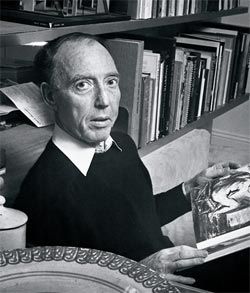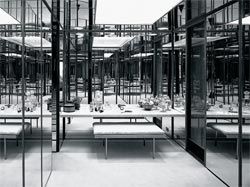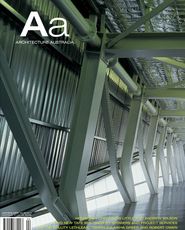ARCHITECT, TEACHER, MAYOR OF WOOLLAHRA, NEVILLE GRUZMAN WAS A CHIMERICAL AND OUTSPOKEN CONTRIBUTOR TO SYDNEY ARCHITECTURE. BRUCE RICKARD AND PHILIP GOAD REMEMBER HIS PASSION, DEDICATION AND WORK.

Neville Gruzman. Photograph Max Dupain.

Gruzman House, Darling Point, 1958, 1965, 1995. Interior view of the mirrored dressing room. Photograph David Moore.
IN 1970, Eric Smith’s portrait of Neville Gruzman won the Archibald Prize. It’s a confronting image. Gruzman’s penetrating eyes stare out and upward from the canvas. This person speaks his mind. He’s sitting on a stool in a short-sleeved shirt, with no background to speak of, no indications that Gruzman was an architect. It’s just him, the person. But the portrait’s frankness belies Gruzman the architect, the man who was always in a suit and whose buildings are complex, unusual, difficult to categorize, intensely personal, serene, shimmering and reflective. “Oh but that’s what Neville is really like”, people would say. His work, like his personality, was chimerical, brilliant, outspoken and assertive. You could not divorce the two.
In the published histories of Australian architecture, Gruzman makes only a limited appearance. Robin Boyd and J. M. Freeland don’t mention him or his work. Jennifer Taylor discusses Gruzman only as a name among what could be loosely described as a Wrightian school in Sydney, and also in terms of the career of Glenn Murcutt. This is surprising but perhaps not unusual, as these histories track “movements” rather than the individualist architects who began their practices in earnest in the 1950s – architects like James Birrell, Peter Burns, Alex Jelinek, Stuart McIntosh, and, of course, Neville Gruzman. As a consequence, these architects sit outside any current architectural canon. At the same time, Gruzman and his works are well known. His houses were consistently published in the late 1950s and early 1960s. Then there was a gap in exposure until 1983, when a commemorative exhibition devoted to Gruzman’s work was held at the RAIA NSW Chapter, and another retrospective in 1992 at the Rex Irwin Gallery in Sydney. These drew considerable and intense interest.
Gruzman was a Sydney architect. Almost all of his work was built in Sydney. Almost all of his public pronouncements were focused on Sydney’s urbanism, architecture and its architectural personalities. Gruzman showed no mercy and for this he raised the hackles of many within the architecture profession, the halls of academe, and at the level of local and state government. Though Gruzman might have believed the opposite, he earned himself notoriety. As Mayor of Woollahra, Gruzman was outspoken (sometimes dangerously so), a vocal supporter or vocal denouncer. His prickly insistence earned him loyal friends and mortal enemies, and for this latter effect he simply didn’t seem to care. He felt that Sydney’s power cliques needed unravelling and that architects should be allowed to criticize each other’s work. He felt that architects should try harder to better their efforts and the appearance of their city. He was passionately committed to his view of the world. He was a stirrer. He was a teacher. He was an architect.
A different but equally compelling portrait of Neville Gruzman might be an architectural one. In his house at Darling Point, Sydney (1958), Gruzman designed in 1965 for his wife Margot a very special dressing room. It’s mirrored on all four sides and on the ceiling. The effect is an infinite number of images in all directions. In a photograph of the space, if one looks closely, there’s a figure slipping from view. It’s the photographer of course, but is it also Gruzman the artist-architect slipping from view, creating the stage for others? Gruzman’s architecture was theatrical and performative. He created the scene and just as quickly disappeared, for others to take his place and live there.
A book about Gruzman is soon to be published. Neville Gruzman produced a unique body of work in Australia and the book’s aim is not to lionize but to bring Gruzman and his work finally into focus, to place it – and him – into a broader, richer and more inclusive discussion of the last fifty years of Australian architecture.
PHILIP GOAD
NEVILLE WAS A complex character with many interests: architecture and town planning (degrees in both), urban design, teaching (adjunct professor at the University of New South Wales), community involvement (Mayor of Woollahra), and writing letters and articles for the Sydney Morning Herald. Whatever his interest he did it with great passion and dedication. Along the way he made many good friends and enemies, for he was single-minded and never compromised.
Among his many friends were his ex-students and ex-staff who respected and admired his work. These included Bruce Eeles, George Guest, Mike Harris, Rob Heath, Mike Hesse, Jorge Hrdina, Geoff Le Sueur, Peter Lonergan, Philip Moore, Glenn Murcutt and Rob Puflett.
Neville began teaching at the University of New South Wales in the 60s with Basil Beerman, Eric Daniels, Doug Gordon, Harry Howard, Peter Kollar, Bill Lucas, Allan Williams and Andrew Young – all recent graduates and young practitioners at the time. He continued to teach up to 2003. His classes were always popular.
Neville asked me to help him in the latter years with his classes of about thirty students. I was amazed at his dedication. He would give individual crits to his students throughout his course, not just in studio time but an extra half-day each week when they had time free of lectures, as well as Saturday morning at his home. He also made his students turn up at his studio on the Monday of long weekends, Anzac Day, Easter, and the week before exams, which is normally allotted to study for the exams. He was never paid for the extra time he spent on these occasions.
Neville wrote an article in the Sydney Morning Heraldcriticizing the superficial teaching of design at the University of New South Wales due to the small amount of studio time allotted to design and the overcrowding of studio classes. This was intended as a constructive action on Neville’s part, protesting against the cost-cutting at universities and the effect this was ultimately having on our built environment. Unfortunately the university chose to view it in a negative light and Neville was not invited back to teach the following year.
I have always been impressed by Neville’s buildings. While they are all different they have several elements in common. They have a beautiful spatial flow, the living areas all face north and they are exquisitely detailed. Several of the houses have particularly moved me – the hexagonal, gridded, organic, bush stone of the Chadwick house with its intimate scale and mysterious passageways; the simple, minimalist but rich Hills house; and the delicate steel and glass cage of the Holland house floating above its rugged site at Middle Cove.
I was fortunate to be entertained by Margot and Neville on many occasions in their own house at Darling Point, which allowed me to experience the beauty and warmth of the place. The living area was a delight, its classical organic interior lovingly complemented by a collection of paintings, sculpture and porcelain from Australia, Europe and Asia that Neville and Margot collected over the years. I’ll remember the house as both joyous and serene, a true reflection of the energy and sensitivity of Neville and Margot. ›› We will miss this vital, warm, enigmatic man.
BRUCE RICKARD















